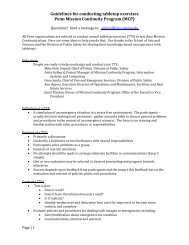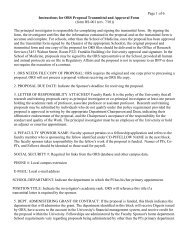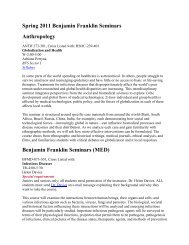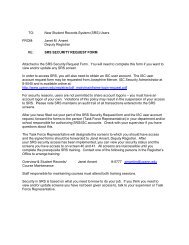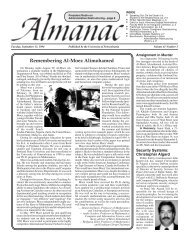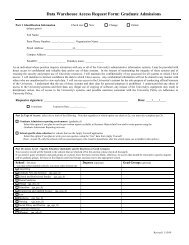PENNPRINTOUT - University of Pennsylvania
PENNPRINTOUT - University of Pennsylvania
PENNPRINTOUT - University of Pennsylvania
You also want an ePaper? Increase the reach of your titles
YUMPU automatically turns print PDFs into web optimized ePapers that Google loves.
ists around campus—in what has been described as a<br />
“skunkworks” project—began meeting to find ways <strong>of</strong><br />
simplifying access to transactional data. SRS was a prime<br />
focus; its data is central to supporting the <strong>University</strong>’s<br />
teaching mission, and its structure, while allowing efficient<br />
day-to-day processing, does not lend itself to the task<br />
<strong>of</strong> analysis.<br />
The <strong>University</strong>’s Data Policy Committee charged<br />
these information specialists to recommend solutions to<br />
the problem. In February 1994, the group’s “Report on<br />
Data Access Strategy” recommended using the warehouse<br />
concept.<br />
The Data Policy Committee accepted the recommendation.<br />
In a textbook example <strong>of</strong> cooperation between the<br />
Schools and central <strong>University</strong> administration, the committee<br />
created a pilot project team with representatives from<br />
Arts and Sciences, Engineering, Wharton, Institutional<br />
Research, <strong>University</strong> Management Information Services<br />
(UMIS), and Data Administration. Over the course <strong>of</strong> the<br />
summer and fall, the team worked through the details <strong>of</strong><br />
the system. There are 2,400 data elements in SRS, and<br />
each one needed to be examined individually: How is it<br />
used in the real world? Does it belong in the Warehouse?<br />
Where? Does it need to be converted or “cleaned up”?<br />
In October, UMIS created a “beta” version <strong>of</strong> the SRS<br />
Warehouse data with 40,000 student records. On December<br />
19, the full version, with data on every student and on<br />
every course section in SRS, was made available for the<br />
project team’s evaluation. Since that time the data has<br />
been updated six nights a week to keep it current.<br />
A work in progress<br />
Having the data available is only part <strong>of</strong> the task. The<br />
other part is providing an easy way to access it. Since the<br />
beginning <strong>of</strong> the project, the Warehouse project team has<br />
been evaluating a number <strong>of</strong> graphical query tools. There<br />
are two kinds. At one level there are “row-and-column”<br />
tools that let you choose from a list <strong>of</strong> data elements,<br />
indicate your selection criteria, and control how you want<br />
the results sorted and totaled. At another level there are<br />
tools that provide a multi-dimensional view <strong>of</strong> the data,<br />
simplifying trend analysis.<br />
Choosing a set <strong>of</strong> query tools has not been easy in<br />
Penn’s multi-platform environment. The ideal “suite” <strong>of</strong><br />
tools would have identical versions for both Windows and<br />
Mac, would integrate Penn’s own help text, and would<br />
allow users to join a local collection <strong>of</strong> data to the central<br />
collection for a specific query. For the initial pilot, the<br />
team selected BusinessObjects as the first-level tool. Sitelicense<br />
negotiations are continuing with several vendors <strong>of</strong><br />
both report and analysis tools.<br />
Another phase <strong>of</strong> populating student data in the<br />
Warehouse has just been completed. Trend analysis and<br />
<strong>of</strong>ficial statistics need a static, point-in-time snapshot <strong>of</strong><br />
the data that will produce exactly the same results now or<br />
10 years from now. These snapshots were moved, term by<br />
term, into the Warehouse.<br />
In the future, the Warehouse will contain more than<br />
student data. Discussions have already begun on adding<br />
Sponsored Projects data to the Warehouse. There is no<br />
reason to stop there; important information from all<br />
transactional systems can be “warehoused.” One advantage<br />
will be the ability to convert the “apples and oranges”<br />
<strong>of</strong> diverse systems to a common denominator.<br />
Of course there are risks in putting <strong>University</strong> data<br />
into the Warehouse. Security is important, but it has a<br />
technical solution. A greater risk is the possibility that the<br />
data may be misinterpreted. Student data is complex. The<br />
Warehouse will simplify access to data, but the data must<br />
still be approached with knowledge and caution. This is<br />
one <strong>of</strong> the reasons Penn has chosen to “roll out” the<br />
The Data<br />
Warehouse saves<br />
programming<br />
time for Schools<br />
and centers<br />
and increases<br />
the range <strong>of</strong><br />
possible analyses<br />
Warehouse slowly; the goal is to have a data structure and<br />
data documentation that, together, minimize the risk <strong>of</strong><br />
misinterpretation.<br />
The Data Warehouse will grow by leaps and bounds.<br />
What’s there now is only a small piece <strong>of</strong> a larger puzzle,<br />
only the first layer <strong>of</strong> a single system. Even so, the<br />
Warehouse has already begun to produce significant<br />
savings in programming time for Schools and centers, and<br />
to increase the range <strong>of</strong> analyses that can be done.<br />
The potential is immense. The foundation <strong>of</strong> a<br />
building has been laid that will—if we’re lucky—never<br />
be complete.<br />
TAD DAVIS is a Lead Programmer Analyst for <strong>University</strong><br />
Management Information Services; DAN SHAPIRO is<br />
Director <strong>of</strong> Institutional Research for the <strong>University</strong> in the<br />
Department <strong>of</strong> Planning and Institutional Research.<br />
APRIL 1995 13





